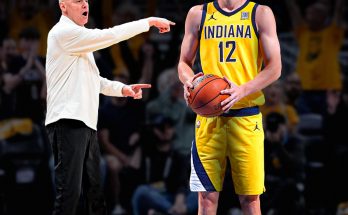“The Buckeyes are set to earn nearly $35 million — and they won’t be the only ones,” reported Rachel Bachman of The Wall Street Journal over the weekend.
The landscape of college athletics is undergoing a seismic transformation, and at the heart of that shift are programs like Ohio State, which are poised to reap enormous financial benefits in the years to come. According to a recent report by Rachel Bachman of The Wall Street Journal, the Buckeyes are projected to bring in close to $35 million annually — a figure that not only underscores the growing financial power of elite college football programs but also signals a new era of revenue sharing and media rights arrangements across the NCAA. And Ohio State isn’t standing alone in this fiscal surge. They are joined by other powerhouse programs in a movement that is redefining what it means to operate a successful collegiate athletic department.
This $35 million number isn’t pulled from thin air; it is the product of evolving media contracts, expanding playoff formats, and a growing appetite for college football content that networks are eager to feed. The College Football Playoff (CFP) expansion, now set to include 12 teams, is driving up the value of broadcasting rights. The Big Ten, Ohio State’s conference, has also struck major new deals with broadcast partners such as Fox, CBS, and NBC. These deals are bringing in billions of dollars over the next decade, and individual schools like Ohio State are seeing a direct line from conference negotiations to their own bank accounts.
For context, the Big Ten’s most recent media rights deal, finalized in 2022, was valued at over $7 billion for seven years. This package included the rights to show games on major national networks, with prime-time matchups and coast-to-coast exposure. Ohio State, as one of the premier brands not only in the Big Ten but in all of college sports, stands as a marquee draw in this deal. Every time the Buckeyes take the field in a nationally televised game, they’re not just competing for wins — they’re showcasing a brand that continues to grow in prestige and value.
The nearly $35 million in projected annual revenue reflects more than just TV rights. It includes a broader slice of the pie from CFP revenues, NCAA distributions, and sponsorship deals that are increasingly tailored for the digital age. Ohio State, with its immense alumni base, loyal fan following, and perennial top-10 football team, is well-positioned to capitalize on every aspect of this financial ecosystem.
But it’s not just Ohio State. Programs like Michigan, Penn State, Alabama, Georgia, and Texas are also projected to enjoy similarly lucrative returns. The financial model of college sports is becoming more top-heavy, rewarding schools that have historically invested in winning programs and built national brands. In this environment, the rich are getting richer, and Ohio State is leading the charge.
The implications of this influx of revenue are far-reaching. Athletic departments are now reconsidering how they allocate resources, with more money available for coaching salaries, facility upgrades, and recruitment strategies. Additionally, with the ever-growing impact of Name, Image, and Likeness (NIL) deals, schools like Ohio State are in a better position to support their athletes in building personal brands and pursuing business opportunities.
It’s worth noting that this revenue growth comes during a time of significant legal and political debate about the future of amateurism in college sports. As players gain more rights to profit from their names and likenesses — and as legal challenges to the NCAA’s traditional model continue to gain traction — schools are preparing for a future where revenue-sharing with athletes might become standard practice. In fact, some are already planning for what that might look like, setting aside portions of their new income to fund potential direct compensation models.
Ohio State’s financial success story is also emblematic of how college football has become a national business. While regional rivalries and conference pride still matter deeply to fans, the scale of the sport now requires programs to think like professional franchises. Brand partnerships, licensing deals, social media strategies, and global marketing initiatives are now part of the playbook. And in every one of those areas, Ohio State is thriving.
Take merchandising, for instance. The Block “O” logo is one of the most recognized symbols in college sports, and it moves massive amounts of apparel annually. Partnerships with companies like Nike have only strengthened the Buckeyes’ reach, and as the team continues to appear on national broadcasts and in the playoff hunt, that reach grows. Every touchdown, every big win, every appearance on ESPN or in a major bowl game helps sell not just tickets, but hoodies, hats, and jerseys from Columbus to California.
Recruiting is another domain where financial strength plays a major role. When high school athletes visit Ohio State’s campus, they’re not just meeting with coaches — they’re touring world-class facilities, interacting with NIL experts, and seeing firsthand what kind of opportunities the Buckeye brand can provide. This holistic view of athlete development, from performance to personal brand building, is an attractive proposition. And now, with even more money flowing into the program, Ohio State can double down on its recruiting infrastructure, ensuring it stays competitive with the likes of Georgia and Alabama.
Academically, the influx of funds can have benefits as well. Athletic departments are often major contributors to university-wide initiatives, especially at flagship public institutions like Ohio State. Increased revenue from athletics can help fund scholarships, academic programs, and infrastructure that benefit the broader student population. In this way, the success of the football team can have ripple effects across the entire university ecosystem.
Of course, with more money comes more scrutiny. As these programs pull in tens of millions of dollars, questions arise about equity, oversight, and the role of college athletics in higher education. Critics argue that the commercialization of college sports has come at a cost — that it has widened the gap between athletic and academic missions, and between the haves and have-nots within the NCAA system. Mid-major programs and smaller schools often struggle to keep up, and some worry that the current trajectory could lead to a bifurcated model where only a handful of schools dominate both the playing field and the financial landscape.
Still, for schools like Ohio State, the moment is one of undeniable opportunity. They have invested for decades in building a powerhouse athletic program, and that investment is now paying off in unprecedented ways. Their football team remains a perennial playoff contender, their fan base is among the most passionate in the country, and their brand is among the most bankable in all of sports — college or pro.
Looking ahead, the college football ecosystem will continue to evolve. The 12-team playoff will create more meaningful games late in the season, driving up ratings and advertising revenue. Media companies will continue to bid for exclusive rights to marquee matchups, with Ohio State games consistently fetching top dollar. Meanwhile, NIL collectives and donor-backed initiatives will become increasingly sophisticated, creating more avenues for athletes to earn and for programs to demonstrate their value.
The long-term future may also include formalized player compensation systems that resemble the revenue-sharing models seen in professional sports. If and when that happens, schools like Ohio State will again be at the forefront — not just because they have the money, but because they have the infrastructure, the alumni support, and the cultural prominence to lead the next chapter of college athletics.
In short, the $35 million figure is more than a headline. It’s a snapshot of where college sports are headed and a testament to the strategic position that Ohio State occupies in this new world. The Buckeyes are no longer just competing for championships — they are participating in a high-stakes, high-reward business that is reshaping the very foundation of collegiate athletics. And with their resources, reputation, and relentless pursuit of excellence, they are poised to be one of the dominant forces in that transformation. They won’t be alone, but they may well be out in front.


